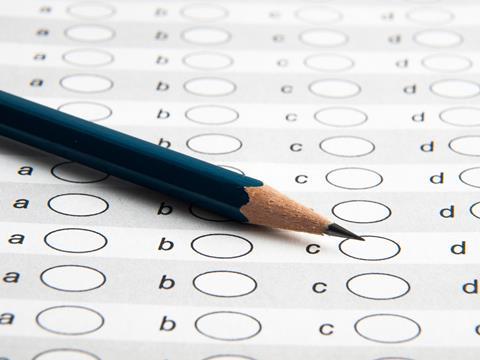Well-designed MCQs can help assess chemical understanding and identify misconceptions

As one of the tools for summative assessment, multiple choice questions (MCQs) offer many advantages. They can be marked reliably and quickly, making them cost and time efficient for large groups, and they can be used to cover a broad range of content within a short test.
However, using MCQs requires careful preparation. For example, it is not easy to write good questions with appropriate distractors (wrong answers) that do not mislead students. Additionally, without careful design, students can gain marks by guessing rather than knowing and understanding the correct answer. For these reasons, MCQs for high stakes testing should be pretested.
MCQs for formative assessment
MCQs can be effectively used in the classroom for formative assessment where some of the constraints of high-stakes testing do not apply. But questions and answers still need to be well designed.
Tailoring answer options can provide useful diagnostic information. This allows teachers to adapt lessons to the needs of their class.
Ordered MCQs can generate feedback about students’ level of understanding. Similarly, answers organised into a ‘confidence grid’ reveal uncertainty, alternative conceptions, and other problems.
Ordered MCQs
In ordered MCQs, the answer options aren’t simply right or wrong, but represent different levels of understanding of an idea. The responses to these questions show the depth of understanding students have developed.
Ordered MCQs are formative in two senses. They not only inform the teaching of the current students, but also lead to further development of the original learning progression.
In one study, a group of researchers developed ordered MCQs about the nature of matter. They found these questions provided information about students’ understanding as effectively as open response questions on the same topic.
Confidence grids

Answers presented in a ‘confidence grid’ help shed light on how confident students are in their answers. Students can show their uncertainties, and their need to guess answers is reduced. Teachers can better understand where problems lie, and can appreciate alternative conceptions their students hold if the distractors are incorrect ideas commonly held by students. Research about students’ ideas about chemistry provides plenty of inspiration for writing questions with confidence grids.
A helping hand
Combining good MCQs with mini whiteboards, Plickers, Socrative, or other ways of collecting responses makes it quick for teachers to collect information about students’ understanding. These tools further help with adapting teaching to meet the needs of the students.
The quality of the answer options is key to effectively supporting learning
Other developments in multiple choice questions have been made possible by the increased use of on-screen assessment, including two-tier questions and adaptive questioning where the route taken through the questions is determined by students’ responses.
Whatever the means of collecting the responses and whatever the question format, the quality of the answer options is key to effectively supporting learning.
Evidence and inspiration
Testing, friend or foe? Theory and practice of assessment and testing gives an overview of testing processes, including multiple choice questions.
To read about strategies to reduce the effect of guessing on test marks awarded for multiple choice questions, such as giving partial credit for answers left blank, see this article.
The outcomes of using ordered multiple choice questions also leads to further development of the original learning progression. This article discusses underlying conceptualizations that have gone into the development of some learning progressions.
This study provides an example of using ordered multiple choice questions to develop an instrument for assessing students’ understanding of the structure and composition of matter.
The emergence of a learning progression in middle school chemistry: The Assessing Students’ Concept of a Substance project at Durham University used MCQs and statistical analysis to demonstrate a progression of ideas in students’ understanding of the nature of matter.
Using a backward design approach to embed assessment in teaching in this issue of School Science Review has information about converting a simple MCQ into a confidence grid format and its potential to allow students to show their uncertainties, and the teacher to understand better where problems lie.
For examples of students’ ideas about chemistry that can be used as inspiration for designing questions in a confidence grid format, see:
- Beyond appearances: Students’ misconceptions about basic chemical ideas
- Chemical Misconceptions: Prevention, Diagnosis and Cure: Classroom resources, Volume 2
- Responsive teaching – a discussion of why Socrative is worthy of space on your smartphone and in your classroom
To find more about work undertaken into the development of effective assessment of chemical understanding, including using MCQs, download the RSC assessment report [pdf].
Mary Whitehouse is an honorary fellow in the University of York Science Education Group, UK. Judith Bennett is the Salters’ professor of science education at the University of York, UK. Lynda Dunlop and Kerry J Knox are lecturers in science education at the University of York, UK
Downloads
RSC assessment report
PDF, Size 0.86 mb









No comments yet